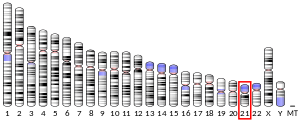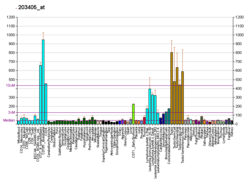References
- 1 2 3 GRCh38: Ensembl release 89: ENSG00000183527 - Ensembl, May 2017
- 1 2 3 GRCm38: Ensembl release 89: ENSMUSG00000022913 - Ensembl, May 2017
- ↑ "Human PubMed Reference:".
- ↑ "Mouse PubMed Reference:".
- ↑ Vidal-Taboada JM, Lu A, Pique M, Pons G, Gil J, Oliva R (Jul 2000). "Down syndrome critical region gene 2: expression during mouse development and in human cell lines indicates a function related to cell proliferation". Biochem Biophys Res Commun. 272 (1): 156–63. doi:10.1006/bbrc.2000.2726. PMID 10872820.
- ↑ Hirano Y, Hayashi H, Iemura S, Hendil KB, Niwa S, Kishimoto T, Kasahara M, Natsume T, Tanaka K, Murata S (Dec 2006). "Cooperation of multiple chaperones required for the assembly of mammalian 20S proteasomes". Mol Cell. 24 (6): 977–84. doi:10.1016/j.molcel.2006.11.015. PMID 17189198.
- ↑ "Entrez Gene: DSCR2 Down syndrome critical region gene 2".
Further reading
- Vidal-Taboada JM, Sanz S, Egeo A, et al. (1998). "Identification and characterization of a new gene from human chromosome 21 between markers D21S343 and D21S268 encoding a leucine-rich protein". Biochem. Biophys. Res. Commun. 250 (3): 547–54. doi:10.1006/bbrc.1998.9352. PMID 9784380.
- Hattori M, Fujiyama A, Taylor TD, et al. (2000). "The DNA sequence of human chromosome 21". Nature. 405 (6784): 311–9. doi:10.1038/35012518. PMID 10830953.
- Strausberg RL, Feingold EA, Grouse LH, et al. (2003). "Generation and initial analysis of more than 15,000 full-length human and mouse cDNA sequences". Proc. Natl. Acad. Sci. U.S.A. 99 (26): 16899–903. doi:10.1073/pnas.242603899. PMC 139241. PMID 12477932.
- Ota T, Suzuki Y, Nishikawa T, et al. (2004). "Complete sequencing and characterization of 21,243 full-length human cDNAs". Nat. Genet. 36 (1): 40–5. doi:10.1038/ng1285. PMID 14702039.
- Gerhard DS, Wagner L, Feingold EA, et al. (2004). "The status, quality, and expansion of the NIH full-length cDNA project: the Mammalian Gene Collection (MGC)". Genome Res. 14 (10B): 2121–7. doi:10.1101/gr.2596504. PMC 528928. PMID 15489334.
- Possik PA, Sommer CA, Issa Hori J, et al. (2005). "DSCR2, a Down syndrome critical region protein, is localized to the endoplasmic reticulum of mammalian cells". European Journal of Histochemistry. 48 (3): 267–72. PMID 15590417.
- Vesa J, Brown Y, Greenfield D, Korenberg JR (2005). "Molecular and cellular characterization of the Down syndrome critical region protein 2". Biochem. Biophys. Res. Commun. 328 (1): 235–42. doi:10.1016/j.bbrc.2004.09.226. PMID 15670775.
- Hirano Y, Hendil KB, Yashiroda H, et al. (2005). "A heterodimeric complex that promotes the assembly of mammalian 20S proteasomes". Nature. 437 (7063): 1381–5. doi:10.1038/nature04106. PMID 16251969.




